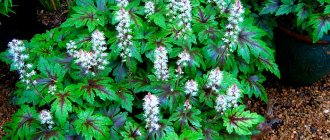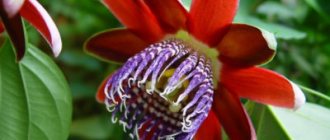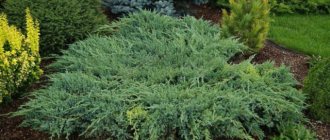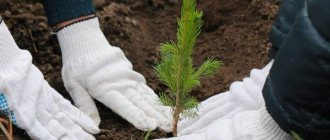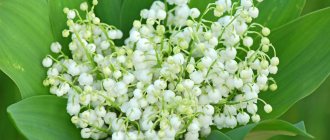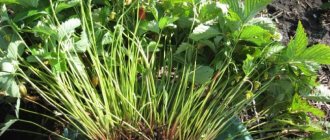What do fuchsia seeds look like?
Fuchsia seeds are obtained from the fruit that is formed as a result of flowering. The achenes are very small, light brown in color, almost flat, and shaped like garlic cloves. In specialized stores you can purchase fuchsia seeds Foxtrot, Holiday, Bella Rosella. On store packaging there is a description of the characteristics of the variety that need to be taken into account when planting.
If you have mature flowering plants at home, you can get seeds for planting from them yourself. Step by step steps on how to do this:
- When the buds begin to open, remove pollen from the male flower with a cotton swab and transfer it to the female pistil.
- Pollination can be carried out between two different plants or on one, using several flowers.
- After the procedure, the flower is sprayed with water and covered with gauze. Moistening increases the chances of pollination, and the fabric will allow you to unmistakably recognize the fruit in which the desired seeds are ripening.
- The ripe fruit is carefully cut off and placed in a paper envelope.
- After the fruit begins to dry out, to prevent mold from appearing, it is placed in the refrigerator.
- Before planting, cut the berries and remove the seeds.
Fuchsia seeds
Important! The ripened fruit acquires a dark color.
Soil preparation
The first thing you should pay attention to when growing this flower is the soil. It can be purchased at a flower shop. For fuchsias, ready-made specialized mixtures for flowering plants are suitable. They have a normal, non-acidic environment, which is ideal for growing strong and viable sprouts. Experienced gardeners prefer to prepare the soil mixture themselves. Today there are 3 known methods:
- a mixture of peat, perlite and sand. They are needed in equal parts;
- crushed sphagnum moss, humus (preferably rotted) and vermiculite to make the soil loose. The components are mixed in equal proportions;
- a mixture of turf, peat, pine bark, sand. The components are prepared in a ratio of 3:1:1:1, respectively.
Before planting, the soil must be disinfected. A weak solution (light pink) of potassium permanganate is suitable for this. During processing, thrips and nematodes are killed, and the likelihood of mold and pathogenic microflora formation is reduced. If you have a special drug “Fitosporin”, it will successfully replace a solution of potassium permanganate.
The container does not play a special role for growing seedlings. The most commonly used are plastic cups or wide containers. The main condition for a container is the presence of a large number of holes for water to drain. A drainage layer (2-3 cm) can be laid at the bottom of the container. Expanded clay or small pebbles are suitable for this.
Sowing seeds
Garlic seeds - cultivation
The best time to plant fuchsia seeds is February, March or April.
The soil
The substrate used is fertile soil (3 parts), peat (2 parts), river sand (1 part). Mix all ingredients well and fill containers. If you cannot prepare the soil yourself, you can use ready-made soil for indoor plants.
Sowing seeds
How to grow fuchsia from seeds at home? Before sowing begins, the soil is spilled with boiling water. This will help get rid of pests and pathogenic bacteria. When the soil has cooled, make small furrows and lay out the seeds. There is no need to bury the seeds and sprinkle them with soil, and this is an important condition for the germination of fuchsia.
For easier sowing, seeds are mixed with sand and distributed over the surface of the soil, then moistened with a spray bottle. Containers with crops are covered with film or glass, leaving a small gap for air. From time to time, moisten the soil using a sprayer or syringe. Once a day, to prevent mold from appearing, glass for 15-20 minutes. cleaned up.
Germination
Germination
Containers with seeds are kept in a bright place, but out of direct sunlight. A comfortable temperature for seed germination should be between 18-20°C. Peat tablets can be used to germinate seeds.
After about 20 days, you can inspect the boxes for the presence of young shoots. The germination period can take up to 30 days, this factor depends on the fuchsia variety.
Important! There is no need to remove the film immediately; the seedlings must get used to the external environment. To do this, increase the time daily, after which the shelter is removed.
Varieties and types of fuchsia with photos and descriptions
A large flowering bush in a container, a standard or ampelous fuchsia will decorate any veranda, terrace or lawn; it is only important to choose the right variety and place.
Our most famous fuchsia is beautiful fuchsia (Fuchsia speciosa), it is also a hybrid (Fuchsia hybrida) - the result of crossing Fuchsia fulgens x Fuchsia splendens (brilliant fuchsia x sparkling fuchsia).
Fuchsia trifoliata.
However, there are several more cultivated species, for example, highland fuchsia Magellanica (Fuchsia Magellanica), its varieties graceful fuchsia (Fuchsia gracilis) and ricartona (Fuchsia magellanica 'Riccartonii') - the ancestors of cold-resistant varieties, as well as heat-loving ones - small-leaved fuchsia (Fuchsia Microphylla) , Bolivian (Fuchsia boliviana) and three-leaf fuchsia (Fuchsia triphylla), which gave rise to triphylla hybrids.
All of the listed species are bushes from 70 cm to 2.5 m in height. Branches can be strong or thin and drooping. Depending on their location and strength, the plant will be compact or spreading.
Among the triphylla hybrids and hybrid fuchsia varieties there are also climbing ones. There are also amazing “weeping” forms with thin long (up to 2 m) shoots, very similar to wild-growing graceful fuchsia. Among the triphylla hybrids, this is the 'Mantilla' variety.
Fuchsia Magellanica 'Riccartonii'.
The Bolivian fuchsia bush is decorated with inflorescences - clusters of long-tubular flowers at the ends of long (up to 30 cm) peduncles.
Fuchsia trifoliate flowers sit densely at the ends of the shoots. Such plants are planted in hanging baskets and balcony boxes.
Further care
Diseases and pests of fuchsia
Fuchsia seedlings develop well with proper care. Water the plants with settled water at room temperature. Moisturizing is necessary as the top part of the soil dries out.
Important! To prevent blackleg disease from appearing, use a slightly pink solution of potassium permanganate for watering or scatter wood ash on the soil.
When the second pair of leaves is formed, young fuchsias can be planted in separate containers with a diameter of 7-9 cm. Expanded clay should be placed at the bottom of the cups and small holes should be made to drain excess water. Using a pencil or other object, make depressions in the soil and carefully, holding the leaves, lower the fuchsias into them.
The transplanted plants are placed in a shaded place where the sun's rays do not penetrate for 1-2 days. This measure is necessary for better adaptation of the sprouts.
Fuchsia in a pot
Caring for plants is impossible without applying fertilizers. Fuchsias especially need additional nutrition during active growth and during the flowering period. For fuchsias, ideal, agricola, and zdraven are suitable. Moreover, all types of fertilizers can be applied only on moist soil.
Folk remedies can be used as additional nutrition.
- Banana peel in the amount of 3 pcs. pour 2 liters of water and infuse for 5 days. Next, the solution is filtered, diluted with water 1:1 and the flowers are watered.
- Wood ash (2 tablespoons) is poured into 1 liter of water. After 2 days, the nutrient solution is ready.
- Onion peel. This component is in every home. To fertilize fuchsias, just soak a handful of onion peels in a three-liter jar for 2 days.
- Castor oil (1 teaspoon) is added to 1 liter of warm water, shaken well and sprayed on the plant. This fertilizing promotes lush flowering.
- Aquarium water. This feeding is effective to use from early spring to mid-summer. Water from the aquarium only on wet soil, since it is also a fertilizer.
Features of the structure of perennial
Fuchsia is an evergreen perennial shrub. The flowers of the plant are bisexual and grow on long stalks. In some types of fuchsia, the sepals are larger in size than the petals themselves and repeat the shape of the corollas; in other types, the petals are wide, large, bright, and the sepals are spread out to the sides.
The stamens and pistil are clearly visible. The leaves are green, with long petioles and strongly depressed veins, and are oval or ovoid in shape with jagged edges.
The flowering period occurs in spring and summer, and the plant produces a lot of flowers.
At the end of the flowering period, fruits - berries - are formed. At home, fuchsia usually grows no more than 80 centimeters in height.
Fuchsia: growing from seeds without problems
How to form a fuchsia bush
When growing a flower from seeds, not everything always goes smoothly. Beginning flower growers may encounter a number of difficulties:
- Yellowing of foliage. If the lower leaves turn yellow, this is normal. When yellowness spreads throughout the plant, this is the result of pest activity. Lack of light, high air temperature, sudden climate change can also be a source of yellowing of leaves.
- Deficiency of iron and magnesium causes chlorosis, as a result of which the leaf blade begins to turn pale. In this case, the plant is fed with iron chelate.
- The leaves are withering. Loss of turgor most often indicates a lack of moisture. This happens during the period of active growth of fuchsia, and also when the flower is systematically flooded. Prolonged exposure to the sun also causes foliage to wilt.
- Few flowers. Poor flowering or its complete absence occurs as a result of heat, dry soil, lack of light, and poor wintering conditions. Buds may fall off due to changes in location and heat.
By following all the rules of care, you can avoid these troubles and grow a healthy flowering plant.
Useful tips from experienced flower growers
In fact, fuchsia does not require much attention. The main thing is to understand something right away before you encounter a problem:
- In order for fuchsias to grow and develop normally, they need to be provided with a lot of light and an influx of fresh air.
- It is recommended to protect plants from direct sun.
- Fuchsias with rich colors require more light than varieties with light colors.
- Growing fuchsia with cuttings is even easier than with seeds.
- Frequent spraying will help young fuchsias grow actively.
- To enjoy flowering, you should maintain the room temperature to 20°C.
- If the fuchsia begins to stretch, it needs to be pinched.
- If plaque has formed on the soil, remove it and add new soil.
- The plant needs to be replanted into a container whose volume exceeds the previous one by only 4-5 cm.
Planting and growing fuchsia from seeds is not difficult. This beautiful plant will definitely thank the gardener with abundant flowering and will decorate any interior. But you will still have to make an effort for this, since you won’t be able to catch a fish out of a pond without difficulty!
Transplanting into pots
Some time after the sowing has been completed, after the second pairs of true leaves appear on the plants, they should be plucked and planted in individual containers:
- Containers for transplantation should be light and small. The ideal option is plastic cups of 100 or 200 ml with holes in the bottom of each of them.
- Planting should be done in the same way as planting seedlings - in a layer of soil and drainage.
- Seedlings need to be very carefully transplanted into cups, leaving the earthen clods intact and sprinkling them with earth.
- After the soil dries, regular but moderate watering of plants in trays or along the edges of containers will be required.
- It is also necessary to periodically spray the seedlings with water using a spray bottle, as well as fertilize them with complex fertilizers, which should be done twice a month.
When pulling out the fuchsia, be sure to pinch it. Otherwise, the bush will not be compact. Cutting off the top is carried out when the plant is actively growing. This way it will be well formed and will be lush, healthy and very strong.
When it becomes noticeable that the seedling cup has become very small, the plant should be transplanted into a pot whose diameter is 2-4 cm larger. When sowing seeds, you can count on the appearance of flowers within a year.
